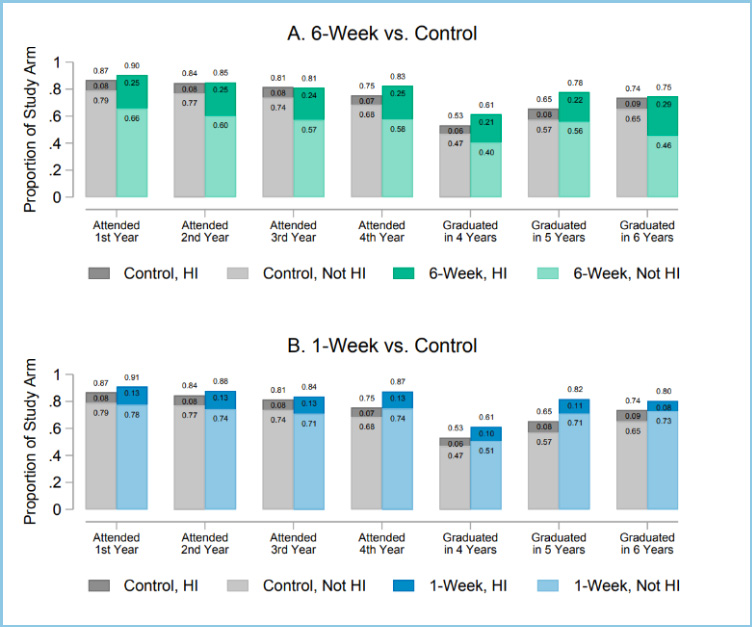New Research: Summer Learning Boosts Math Performance, College Graduation
As federal policymakers grasp for tools to combat learning loss, a variety of summer programs could offer benefits in both the K-12 years & afterwards

Get stories like these delivered straight to your inbox. Sign up for The 74 Newsletter
With August underway, America’s kids have begun nervously counting the days until vacation ends, while their parents are eyeing back-to-school sales and carpool schedules. But the education policy world is still soaking in the glories of summer — or, more precisely, summer school.
New research released last month has offered persuasive new evidence of the potential of summer learning opportunities, particularly in STEM subjects. One, a meta-analysis compiling the findings of dozens of prior studies over the last two years, shows consistent gains in math achievement resulting from student enrollment in summer coursework. Another showed participants in a summer STEM program enjoying significant later-life benefits, including greater success in college and higher earnings.
The papers emerged just as national leaders made a concerted push to broaden access to summer instruction. In July, the White House exhorted state and district leaders to spend more of their federal relief funds on tutoring, afterschool activities, and summer enrichment. Next, the Department of Education launched the Engage Every Student Initiative, a public-private partnership designed to guide local communities toward evidence-based programming. The administration even sent First Lady Jill Biden on the road to highlight the work of schools that have expanded their summer offerings.
The campaign demonstrates the promise that many experts see in summer learning — and the enormous academic challenges facing the nation’s schools after three school years disrupted by COVID-19. Along with extended school days and a stiff dose of high-quality tutoring, researchers and policymakers alike are turning to the traditionally vacant summer months as an untapped resource in the battle against academic erosion.
Kathleen Lynch, an assistant professor at the University of Connecticut and coauthor of the meta-analysis, said the existing research shows not only that summer learning is an effective means of bolstering academic growth, but also a worthy recipient of finite COVID recovery dollars.
“Summer programs provide an opportunity for children to catch up on material they may have missed, or to enrich their learning on new topics aligned with their interests,” Lynch wrote in an email. “I would recommend an effort to replicate successful models over the next few years, as schools and districts continue to combat learning setbacks that children experienced due to the pandemic.”
Lynch and her co-authors cast a wide net to gather relevant findings from existing research dating between 1998 and 2020, ultimately selecting 37 studies of summer math initiatives that included control groups against whom program effects could be assessed. Programs could be conducted in a school, a community site, or private homes, and while some of the experiments were exclusively math-focused, others provided instruction in other subjects as well.
Participation in the programs significantly lifted children’s math performance. The average effect size of .1 standard deviations (a common measure showing the difference in any group from the statistical mean) in improved standardized test scores compares favorably to other touted learning interventions, such as teacher merit pay and school choice. And the benefits were similar in scope regardless of whether a given program served primarily low-income or high-income children.
That distinction is critical given the intense diversity of summer learning experiences. Many are operated by school districts on a remedial basis, recruiting (or requiring the participation of) students who struggled academically during the year. Historically, these forms of summer school have struggled with poor attendance and low engagement from participants.
By contrast, Lynch noted, “contemporary summer programs increasingly focus on enrichment, hands-on activities, and learning via projects and inquiry.” Such programs, offered electively, are more likely to attract high-achieving pupils from relatively advantaged families.
Another paper released in July focused on a particular initiative that attempted to split the difference by signing up high-achieving students from racial or ethnic backgrounds that are historically underrepresented in STEM fields. The program, offered by an elite technical university located in the Northeast, draws a disproportionately nonwhite field of rising high school seniors with top test scores and an average GPA of 3.86.
Researchers from Columbia Teachers College, the Harvard Kennedy School, and the consulting company Mathematica assessed the effects of three separate varieties of the program: two summer residential periods (one week and six weeks, respectively) on campus, complete with direct coursework in STEM subjects as well as workshops and visits to STEM-focused workplaces, as well as a six-month engagement that was primarily offered to participants online.
In all, participants from the 2014, 2015, and 2016 cohorts of experiment gained impressive life advantages in the years to come. Across all three summer offerings, students were more likely than members of a demographically similar control group to enroll in college, as well as persist and finish with a degree. Perhaps most importantly, since the program’s top priority was to diversify the STEM pipeline, participants offered seats in the six-week residential experience were 33 percent more likely to graduate in four years with a STEM degree.
Sarah Cohodes, an associate professor of economics and education at Teachers College, Columbia University, and a co-author of the study, said that the experiment provides evidence of a somewhat rarefied type of summer learning opportunity, tailored to students who were likely to enjoy its full benefits. That makes it a limited, though suggestive, window into what can be expected from summer school generally.
“Does it look like what we’re thinking about when we’re thinking about remediating learning loss? No, it doesn’t,” Cohodes said. “But I think you can see this as an existence proof that, yes, carefully designed programs targeted at the right level for students can make a huge difference for their life trajectories, and it is possible to create summer opportunities that change the lives of students.”

Intriguingly, the study’s findings in terms of college outcomes aren’t clearly attributable to a particular facet of the college program; for instance, graduation rates after five years with a STEM degree were not significantly different in the one-week experience versus the six-week experience. This suggests that the benefits might be attributable to the simple influence of gathering students from traditionally underrepresented groups together on a prestigious campus, Cohodes argued.
“It’s not clear that the learning that made a difference here was standard, ‘I know more physics than I knew before’-type learning,” she observed. “A lot of it seemed to be around knowledge of the college application process, knowledge of what was out there, peer effects and social networks.”
The development of non-cognitive skills and traits was an explicit point of focus in Lynch’s compilation of summer learning studies. Across a range of 37 non-cognitive outcomes (including mindsets and attitudes, social skills, and academic behaviors like school attendance), summer math programs were associated with positive movement in 27; the average effect size for those outcomes was roughly equivalent to the programs’ effects on math test scores and course grades, with notable reductions to school-year absenteeism.
“The number of studies that measured noncognitive impacts is relatively small, but the evidence we found suggested that there’s unlikely to be a tradeoff between learning and noncognitive outcomes from attending summer programs,” Lynch said.
One example singled out in the meta-analysis was the Horizons National Summer Enrichment Program, an intensive summer intervention serving thousands of low-income pre-K–8 students across dozens of affiliates in 20 states. A 2018 report commissioned by the organization found that its enrollees were less likely to be chronically absent or repeat a grade. A Horizons affiliate in New Haven, Connecticut, was one of the stops on the first lady’s July tour of summer learning and enrichment programs.
As policymakers at the state and federal levels search for tools to restore the academic growth forfeited during the pandemic, they will have access to thousands of existing summer schools, camps, and enrichment activities targeted toward K-12 students of different ages and achievement levels. National Summer Learning Association CEO Aaron Dworkin, who accompanied First Lady Biden on her visit to Horizons, said in an interview that this panoply of approaches — wedded to ample government support — could make a significant impact in the next few years.
“We have a lot of people who are doing what they think is best, but we can support and train them and invest in them so that they don’t have to reinvent the wheel. A lot of people have tried already and learned the hard way. What’s different is that we have a lot of training, data, intermediaries, and infrastructure to support all kinds of people who are trying to be helpful right now.”
Get stories like these delivered straight to your inbox. Sign up for The 74 Newsletter


